Affiliate Disclaimer
Some links in this article are affiliate links. We may earn a small commission if you make a purchase through these links, at no extra cost to you. We only recommend products we find useful to our readersA strong back is essential to good posture, injury prevention, and overall fitness. However, we often overlook it when training for body weight. The good news is that you don’t need a gym or any equipment to strengthen your back.
Using only your body weight, you can effectively target key muscles of the back, including the traps, lats, and lower back, to enhance your posture and strength.
In this article, we’ll examine the best bodyweight exercises for your back, how they work, and how to plan an effective workout with them.
If you’re trying to correct slouching, alleviate back pain, or enhance your athletic performance, these simple and effective exercises are what you need. They require no equipment and are perfect for your home routine. Let’s get started!
5 Top Bodyweight Back Exercises
Here are five of the most effective exercises you can practice without any equipment.
1. Superman Hold
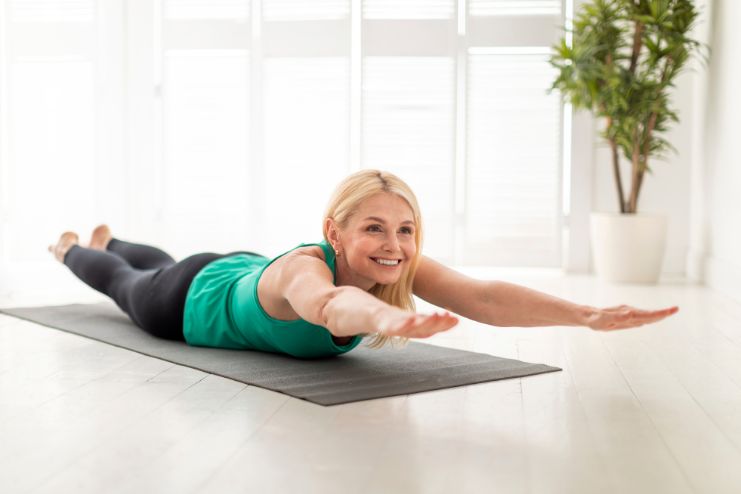
The Superman hold is excellent for any fitness routine as it works the lower back, glutes, and hamstrings. Strengthening the core helps maintain spinal support, good posture, and injury prevention.
How to Do the Superman Hold
- Lie face down on the floor with your arms extended forward and legs straight
- While keeping your head neutral, lift your arms, chest, and legs a few inches off the ground
- Engage your glutes and lower back muscles and hold that position for 2-3 seconds
- Slowly come down to the ground with arms, chest, and legs
- Do 2-3 sets of 8-12 repetitions
Muscle Activation: Activates the erector spinae, a group of muscles extending along the spine. The glutes and hamstrings extend the hips and stabilize the pelvis. The core muscles activate to hold the spine stable.
Don’t try to hyperextend your neck or to lift higher than is comfortable. If challenging, begin only with lifting your arms.
2. Reverse Snow Angels
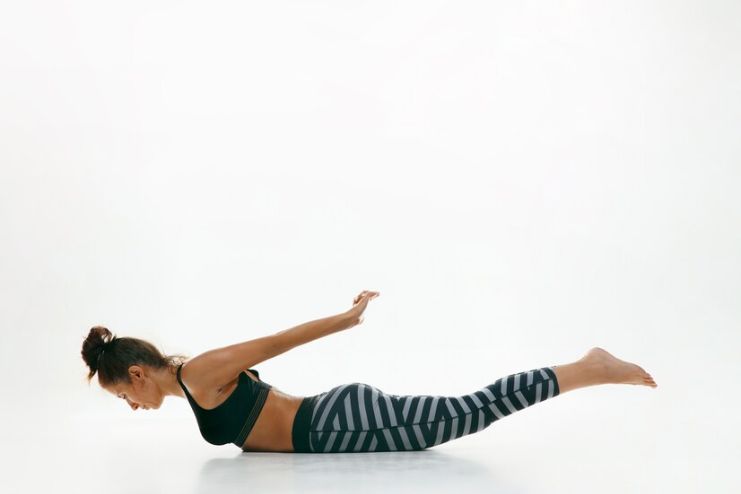
The Reverse Snow Angel helps strengthen your upper and mid-back muscles, including your lats, rhomboids, and levator scapulae. It also involves the glutes, core, and shoulders, making it perfect for posture correction and strength development in the back.
How to Do the Reverse Snow Angel
- Lie prone on the floor or a mat with legs extended and feet together
- Place your arms by your sides, palms down
- Slightly raise chest, arms, and legs into the air while activating the core and glutes
- Move your arms in a wide arc overhead, mimicking a snow angel motion
- Return them to your sides with fingertips pointing toward your feet
- Ensuring your shoulders and back remain engaged
- Aim for 3 sets of 12 repetitions
Muscle Activation: Activates the lats, rhomboids, and levator scapulae, which pull the shoulder blades back and down. The deltoids, or shoulder muscles, help to stabilize the shoulder joint. The core muscles, especially the abdominals and obliques, engage to maintain a stable position. The glutes also activate to keep the pelvis in a neutral position.
3. Bird-Dog
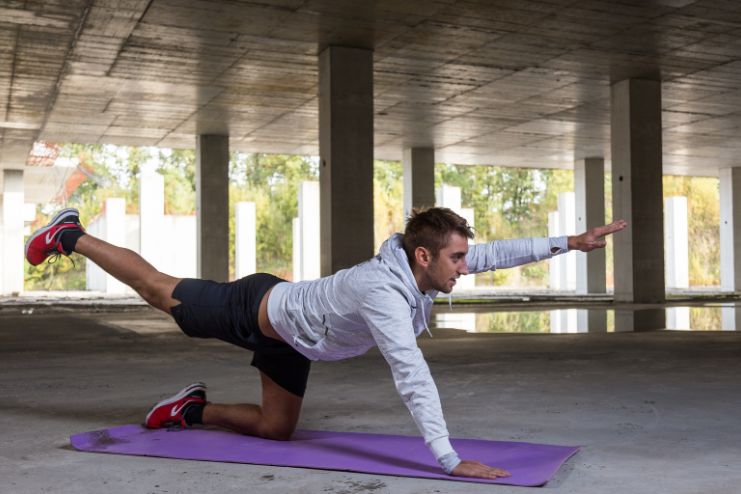
The Bird Dog helps improve core strength, spinal stability, and overall balance. It works the abdominals, lower back, glutes, and shoulders. It improves posture and helps reduce lower back pain. It’s suitable for people with different fitness levels.
How to Do the Bird Dog
- Begin on all fours with your hands under your shoulders and knees under your hips
- Maintain a neutral spine and engaged abductors
- Slowly reach out with your right arm and left leg, keeping hips and shoulders level
- Hold for a few seconds, maintaining proper body position
- Lower your arm and leg
- Repeat this movement using your left arm and right leg
- Do 2 – 3 sets of 8 – 12 reps per side
- Move slowly and with control, keeping your spine neutral and avoiding any rotation
Muscle Activation: The rectus abdominis, obliques, and transverse abdominis are activated. These muscles help stabilize the trunk. The glutes activate to stabilize the pelvis and extend the hip. The hamstrings help with leg extension. The erector spinae stabilizes the spine.
4. Hip Bridge
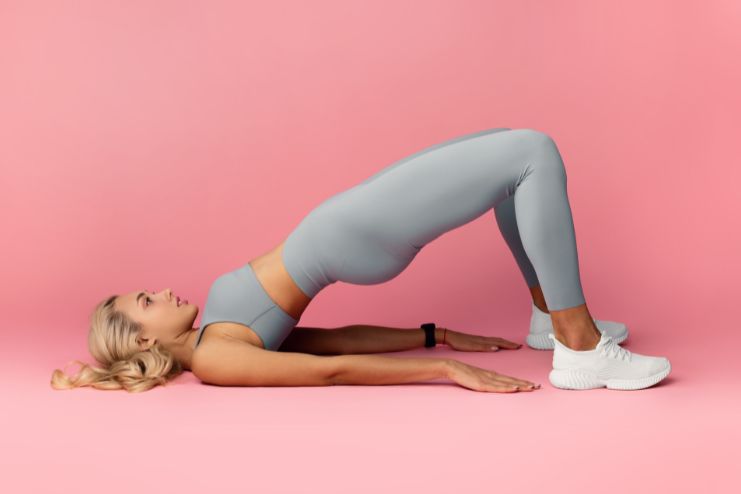
The hip bridge is a versatile exercise targeting different parts of the body, including the glutes, hamstrings, and lower back. It enhances core stability while preventing or alleviating back problems, improving posture, and building strength. It is a simple and effective exercise that can be modified or advanced.
How to Perform the Basic Hip Bridge
- Lie on your back with knees bent, feet flat on the floor, and arms by your sides
- Press down on the heels and lift your hips into a position that forms a straight line from shoulders to knees
- Squeeze glutes, keeping hold for a few seconds at the top
- Slowly lower your hips back to the ground
- Do 2 – 3 sets of 10 – 12 repetitions
Muscle Activation: The main muscle used is your gluteus maximus. Hamstrings help extend your hips. Erector spinae muscles in your lower back stabilize your spine as you engage abdominals (specifically, your rectus abdominis and obliques).
5. Wall Angels
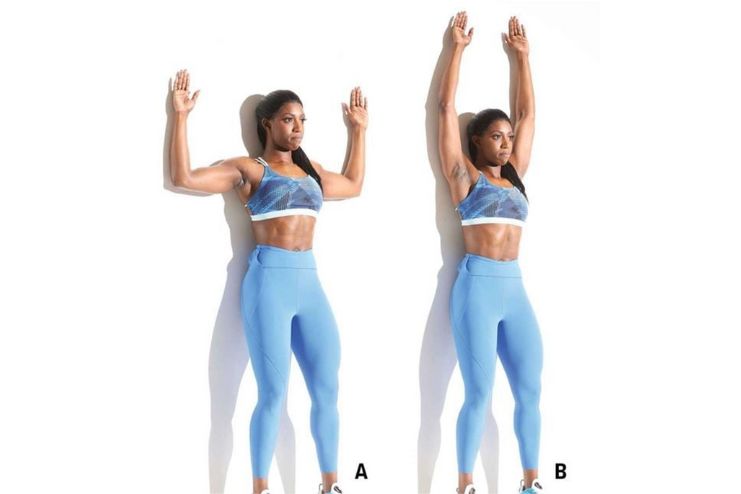
Wall Angels is an easy yet effective exercise for countering poor posture due to prolonged sitting or “tech neck.” It stretches the chest and shoulder muscles while strengthening the upper back and the core, making it perfect for improving alignment and keeping the strain off your neck and shoulders.
How to Do The Wall Angels
- Stand with your back against a wall, feet 6 – 8 inches apart
- Align your head, shoulders, and butt with the wall
- Tuck your chin and draw your belly button into your body for a neutral spine
- Lift your arms to a “V” position on the wall
- Slowly move them down into a “W”
- Raise your arms back to the initial position, maintaining contact with the wall
- Repeat for 5 – 10 repetitions, focusing on posture
Muscle Activation: Wall Angels activate the latissimus dorsi, rhomboids, trapezius, and deltoids. These muscles are responsible for shoulder mobility and upper back strength. The rectus abdominis and obliques engage to maintain a neutral spine. The pectoralis major and minor (chest muscles) also activate as they are stretched.
If keeping your back or arms completely against the wall is difficult, begin with an easier version using a doorway as a support.
Workout Routine Example
Here’s a back-focused circuit using the exercises mentioned above. This workout routine targets the significant muscles in your back, core, and glutes to improve strength, stability, and posture. Practice this workout at home with just a yoga mat and no equipment.
Warm-Up (5-10 minutes)
- Begin with some light cardio, like brisk walking, jogging in place, or jumping jacks, to get your heart rate going for 3 – 5 minutes.
- Dynamic stretches like arm circles and hip rotations prepare the muscles for work.
Circuit: 3 Rounds
Do each exercise for 30 seconds to 1 minute. Rest for 30 seconds between exercises. Rest for 1 – 2 minutes after each round. Do 3 such rounds.
- Superman Exercise: Avoid hyperextending your lower back. Keep your movements controlled and focus on using the back muscles for lift.
- Reverse Snow Angel: Engage your core to support your lower back and control the movement. Aim for smooth, controlled motion.
- Bird Dog: Keep your back and hips level, engaging your core to stabilize the movement. Avoid bending or arching your spine.
- Hip Bridge: Allow your upper back and shoulders to rest on the floor so that your lower back does not over-arch at the top of the bridge.
- Wall Angels: Engage your core to avoid arching your back. Try not to scrunch your chest open or relax your shoulders as you move your arms up.
Cooldown (5-10 minutes)
- Stretching: Focus on back, shoulders, and hip stretches. Here are a few to try:
- Cat-Cow Stretch
- Child’s Pose
- Chest Opener Stretch
- Seated Forward Fold
Adjust the duration or number of reps if any exercises feel too difficult.
Progression Tips
- Slow down the movement to increase time and muscle activation
- Gradually increase the repetitions or the duration of holding a position
- Utilize weights or resistance bands to make it more challenging
- Add more sets or supersets
- Add more challenging movements, such as single-leg variations, to the exercise
Conclusion
Strengthening the back is key to good posture, preventing injuries, and improving your overall fitness. You can target key muscles, including the lats, traps, and lower back muscles, using workouts that help improve spinal support, stability, and alignment.
The exercises we mentioned above are easy to practice at home. No equipment is necessary, just your body’s strength.
These exercises will work your back muscles and activate the core, glutes, and shoulders to create a balanced and functional physique. Long-term practice will reduce your backache and correct your posture and performance.
Start with these basic movements, and as you slowly get stronger and more flexible, you can try more challenging variations.
Consistency is key; incorporate these exercises regularly into your routine for long-lasting benefits.
References
In this Article
















